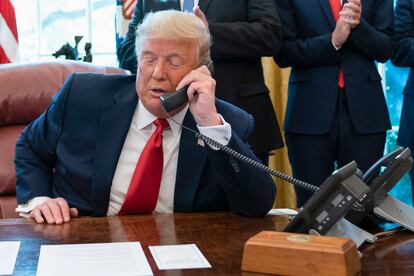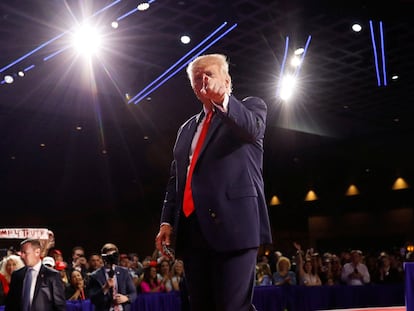What is missing from the gap in Donald Trump’s call log during the attack on the Capitol?
The House select committee investigating the January 6, 2021 assault has found nothing during a seven-hour period in the White House logs that were handed over as evidence in the probe


Who did Donald Trump call between 11.17am and 6.54pm on January 6, 2021? Who did he speak to as the attack on the Capitol – that he himself had instigated at a prior rally with thousands of supporters – was taking place? There is no answer to these questions in the White House archives. The House select committee that is now investigating the events of that day has found a gap in the telephone registries of the then-president, according to an exclusive story published jointly by The Washington Post and television network CBS News. The seven hours, or 457 minutes, is an eternity for the investigators, a time during which the home of democracy in Washington was being violently assaulted by a mob, and then-vice president Mike Pence and other lawmakers had to seek shelter.
Does this gap in the records mean that Trump destroyed those call registers, which the Supreme Court ordered to be handed over in January with the rest of his presidential documents? This is one of the theories being considered. Another is that the president was able to use different telephones to communicate with others, something that is prohibited by law. What seems to be clear is that he did not remain quiet. The data about calls made or received by the White House switchboard occupy 11 pages, which confirm that the businessman-turned-politician had a high number of calls over the rest of the day.
In the morning, he called eight people and then another 11 during the night, before and after the gap that has just come to light. What’s more, there is public evidence that during that seven-hour period he communicated with – or at least tried to – Republican Senator Mike Lee (Utah) and Tommy Tuberville (Alabama), as well as with the House Minority Leader Kevin McCarthy (California).
The January 6 records that survived, and which can be consulted here, show that Trump spoke to or requested to speak to some key players: former White House strategist Steve Bannon, who in November surrendered to the FBI after having been accused of contempt of Congress for defying a subpoena from the committee investigating the attack on the Capitol; his personal lawyer Rudy Guliani, who has been facing a series of legal problems for his role in spreading false theories about alleged electoral fraud at the 2020 presidential election; and his chief of staff Mark Meadows, who, it has emerged, was pressured by Ginni Thomas, the wife of Supreme Court Judge Clarence Thomas, to do everything possible to reverse the Democrats’ victory at the elections. He also spoke to Senate minority leader and Kentucky senator Mitch McConnell, and with the then-vice president Mike Pence, who he was calling on that day to stop the transfer of powers to president elect Joe Biden.
The committee investigating the events of January 6 is trying to determine whether Trump used other channels – his assistants’ phones or “burner” cellphones – to communicate, according to the story published in The Washington Post, and which carries the byline of Carl Bernstein, who uncovered the Watergate scandal 50 years ago, and Robert Costa, political correspondent from CBS news.
Tearing up records
Trump did not exactly show respect for the Presidential Records Act, which determines that these communications are the property of the United States, and not the occupant of the White House. In February, it emerged that he would regularly tear up documents with sensitive information, and that when he left office, he took classified papers and information that was key to national security to his Mar-a-Lago resort in Florida, as was confirmed by the National Archives and Records Administration (NARA).
According to sources from the administration, it was also normal for Trump to use different phones to communicate with his staff, who would get calls from the White House switchboard or from different numbers. On occasions, people would hear the president’s voice after picking up a call from a hidden number.
In a statement issued on Monday night, Trump said: “I have no idea what a burner phone is, to the best of my knowledge I have never even heard the term.” A spokesperson for the former president explained to Woodward and Costa that Trump had nothing to do with the records and that as far as he knew all of his calls were recorded and preserved.
Tu suscripción se está usando en otro dispositivo
¿Quieres añadir otro usuario a tu suscripción?
Si continúas leyendo en este dispositivo, no se podrá leer en el otro.
FlechaTu suscripción se está usando en otro dispositivo y solo puedes acceder a EL PAÍS desde un dispositivo a la vez.
Si quieres compartir tu cuenta, cambia tu suscripción a la modalidad Premium, así podrás añadir otro usuario. Cada uno accederá con su propia cuenta de email, lo que os permitirá personalizar vuestra experiencia en EL PAÍS.
¿Tienes una suscripción de empresa? Accede aquí para contratar más cuentas.
En el caso de no saber quién está usando tu cuenta, te recomendamos cambiar tu contraseña aquí.
Si decides continuar compartiendo tu cuenta, este mensaje se mostrará en tu dispositivo y en el de la otra persona que está usando tu cuenta de forma indefinida, afectando a tu experiencia de lectura. Puedes consultar aquí los términos y condiciones de la suscripción digital.
More information
Archived In
Últimas noticias
The murder of Michele and Rob Reiner: A tale of horrific days in Hollywood
Trump orders a ‘complete blockade of sanctioned oil tankers’ going to and from Venezuela
Not all insomnia is the same: Study identifies five subtypes and paves the way for personalized treatment
The United States designates Clan del Golfo as a foreign terrorist group
Most viewed
- ‘El Limones’ and the growing union disguise of Mexican organized crime
- Christian Louboutin: ‘Young people don’t want to be like their parents. And if their parents wear sneakers, they’re going to look for something else’
- ‘We are dying’: Cuba sinks into a health crisis amid medicine shortages and misdiagnosis
- A mountaineer, accused of manslaughter for the death of his partner during a climb: He silenced his phone and refused a helicopter rescue
- The low-cost creative revolution: How technology is making art accessible to everyone










































